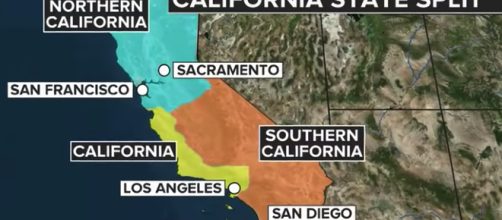This fall, among their typically large crop of ballot propositions, Californians will get to decide whether they want to split their state into three. Silicon Valley billionaire Tim Draper has managed to gather enough signatures to get his controversial plan to slice the Golden State into roughly equal thirds, onto the November ballot.
While money played a substantial role in getting the so-called “Cal 3” initiative in front of voters—the gathering of the necessary signatures only picked up steam once vendors were promised $3 per signature they collected.
Some Californians, on both the left and the right, genuinely support the proposed division. Northern Californians are tempted by the fact that splitting off would make them the second-wealthiest state in the country per capita. Republicans in the Central Valley, meanwhile, have voiced cautious hopes that one of the three new states created, which Draper has named “Southern California,” could turn red.
Draper himself—who’s already sunk more than $5 million into previous attempts to chop California up into chunks—argues that the Golden State is too big to govern efficiently, and that the various problems plaguing the state, from high taxes to infrastructure badly in need of repair, would be easier solved by three smaller, more flexible governments.
Draper’s argument relies on some logical points: California’s population, the largest in the nation and fast closing in on 40 million, does seem underrepresented with only two senators, and it’s difficult to deny that, if say, Fresno and Palo Alto have different priorities.
The real cost of ballot propositions
Unfortunately, Draper’s proposal is the latest in a long line of well-intentioned but fatally-flawed California propositions.
At best, it’s a waste of time and money. On average, each qualifying signature for a California ballot initiative costs $6.20, while the need to now mount an official campaign opposing Draper’s plan—despite the fact that only 17 percent of Californians currently support it—is sapping resources from addressing other issues affecting the state.
At worst, if Cal 3 actually managed to pass, California could spend years trying to get the federal government to go along with the plan, as well as battling internally over how to solve a laundry list of issues. These would include securing water supply to each of the three new states, dividing up the state’s current debts, through to determining who would be eligible for in-state tuition at the University of California system.
Well-intended but misguided
California has a worrying history of approving ballot measures with laudable goals that then created more problems than they were worth. One of the state’s most famous initiatives, Proposition 65, was passed in 1986 with the admirable aim of making sure Californians had access to clean water and were adequately informed about harmful chemicals they might be exposed to.
Four decades later, consumers are so saturated with hyperbolic warning signs plastered in every California parking lot, hotel, and restaurant that the signs have become meaningless. A lucrative racket has sprung up among ‘bounty-hunters’ who pounce on businesses that have neglected to post the warning. Substances have been added to the list of “known carcinogens” on the basis of extremely flimsy evidence, causing federal courts to have to reexamine these chemicals’ listings one by one.
Just last week, federal judge William Shubb upheld his February ruling that products containing glyphosate, the world’s most popular herbicide, do not have to carry Proposition 65 warnings. According to Shubb, such warnings would be “false and misleading.” Glyphosate was added to the Proposition 65 list despite having been found safe by the EPA and other major international organizations, on the strength of a single, flawed report.
A few days later, the California agency that oversees Proposition 65 warnings backtracked on widely criticized plans to slap cancer advisories on coffee, admitting that “extensive scientific evidence” demonstrated that drinking coffee was not carcinogenic and could even reduce the risk of some types of cancer. These escalating failures have led even some of Proposition 65’s formerly ardent defenders to suggest that the law urgently needs to be revised or axed.
Worsening inequalities
Proposition 65 is not the only well-meaning California ballot measure to have turned out to be a disappointment. In 1978, California’s electorate passed Proposition 13, which capped property tax increases in an effort to protect elderly homeowners from being priced out of their homes.
Proposition 13 addressed a very real issue—the median value of a house in California had jumped by more than 250 percent between 1970 and 1980, without a corresponding rise in income—but has unleashed a cascade of unfortunate side effects.
For instance, Proposition 13 exacerbated existing inequalities. Tax relief from the ballot measure correlates almost perfectly with income, and über-wealthy Palo Alto has the lowest average property tax rate in the state—and created new ones. The property tax freeze enriched a generation of older homeowners, whose home values skyrocketed even as their taxes stayed roughly constant and in the process locked prospective young and minority buyers out of homeownership.
The property tax freeze’s effects spread to numerous other sectors of the Californian economy, as well. In the wake of Proposition 13’s entry into force, the state government gained progressively more control over local spending. Land-use policies changed, leading to a dearth of residential areas. State support for the University of California system dropped by almost half, requiring students to make up the shortfall.
As one California political analyst remarked, this plethora of unintended consequences illustrates the problem with the ballot measures that many Californians consider an essential part of their democracy. Even when ballot propositions work as intended, they often have “wide-ranging and unexpected effects years in the future.”
It’s extraordinarily unlikely that Californians will vote in November to cleave their state in thirds. However, the improbable plan provides them with an opportunity to consider another wide-ranging reform: how to revamp the costly and unintentionally harmful ballot proposition system.


